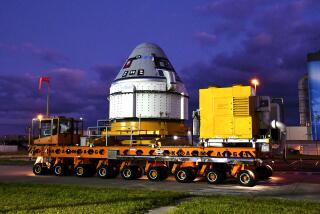NASA Decides Not to Let Bit of Foam Stop Launch
- Share via
CAPE CANAVERAL, Fla. — NASA officials decided to attempt an Independence Day launch of the space shuttle despite the discovery of a piece of broken foam from the shuttle’s 15-story-tall external fuel tank.
An inspection of the damaged area “showed the foam is acceptable and ready to go fly,” said Bill Gerstenmaier, associate administrator for space operations, after a lengthy meeting with mission managers.
The decision to launch came after daylong consultations with NASA’s top engineers, who finally decided that the absence of a piece of foam would not allow too much heating of the tank during launch or the formation of too much ice outside the tank when the super-cooled liquid hydrogen and oxygen fuels were added.
Gerstenmaier said engineers jerry-rigged a camera on the end of a flexible pipe and took pictures inches from the damage area before concluding the foam was in no danger of flaking off.
The launch is scheduled for 11:38 a.m. PDT. The latest forecasts indicate a 60% probability of good weather in central Florida, after days of rain, thundershowers and dark clouds shrouded the launch site.
The broken foam was found during a routine inspection by launch pad workers Sunday night.
Engineers speculated the roughly 3-inch-long, triangular foam chunk weighing less than a tenth of an ounce was “pinched” off as the 0.1-inch-thick aluminum tank shrank and swelled during filling and emptying.
The foam broke away from a bracket holding a liquid-oxygen fuel line in place.
Engineers determined that the piece of foam, had it come off during launch, would not have seriously damaged the shuttle. The piece would have missed the delicate wing-leading edges and instead smacked into the tougher thermal tile on the underside of the craft.
Still, observers said, the event showed that three years after the shuttle Columbia was destroyed -- from damage caused by a piece of falling foam -- NASA still has not mastered its foam troubles.
Earlier Monday, the chairman of the mission management team, John Shannon, said the decision to go forward with a launch attempt would depend on three factors.
The first was making sure enough insulating foam was left in the area of the missing chunk to prevent the formation of ice on the outside of the tank when the fuel is added. Ice breaking off and hitting the orbiter is considered a potentially serious threat to the seven-person crew. The liquid hydrogen and oxygen are cooled to a temperature range between minus 298 degrees and minus 423 degrees.
Second, the engineers wanted to be satisfied that enough foam would be left in the damage area to prevent the aluminum tank from overheating during the ascent.
Gerstenmaier said there was “plenty of margin” with the remaining foam to guarantee no excessive heating.
He also said the amount of ice that could form during fueling was 0.005 pounds, well below the maximum of 0.024 pounds.
The biggest challenge was making sure the surrounding foam had not been weakened so much that it would break away on launch.
Gerstenmaier said the team was on the brink of deciding to put off the launch pending a “hands-on” inspection when an enterprising launch pad worker came up with the idea of a camera on a stick.
“We looked all around the bracket,” said Gerstenmaier. “We found nothing abnormal.”
Today is expected to yield the best weather of a week that has been punctuated with thunderstorms and heavy cloud formations.
Gerstenmaier denied that the decision to launch today shows the agency is suffering from “go fever,” a term referring to an instinctive desire to launch, no matter what, that characterized the Apollo days.
Gerstenmaier said the mission managers asked themselves constantly, “ ‘Are we pushing too hard?’
“The answer is no.”
He also said weather played no role in the decision.
There were no dissenters to the decision to try for a launch today, Gerstenmaier said.
Andy Thomas, 55, an astronaut from Australia who flew on last year’s troubled mission, said he was not worried about the broken foam.
“It’s very small, and it’s very light,” he said of the foam chunk. He said he would climb aboard without hesitation.
“I did it last year, and we know more now than we did last year,” he said.
NASA Administrator Michael D. Griffin has been criticized for moving forward with the current shuttle mission without resolving another foam problem, this one involving a group of parts known as ice frost ramps, which cover 34 brackets on the external fuel tank, not far from the spot where the foam chunk came off Sunday.
Even though three small pieces of foam came off the ice frost ramps during last year’s launch of Discovery -- the first launch since the Columbia disaster -- Griffin said the danger of these bits of foam harming the craft was minimal.
Griffin has said he wants to see how the shuttle performs with the modifications made after last year’s launch before tinkering with the ice frost ramps.
Times staff writer Jia-Rui Chong contributed to this report.
More to Read
Sign up for Essential California
The most important California stories and recommendations in your inbox every morning.
You may occasionally receive promotional content from the Los Angeles Times.













